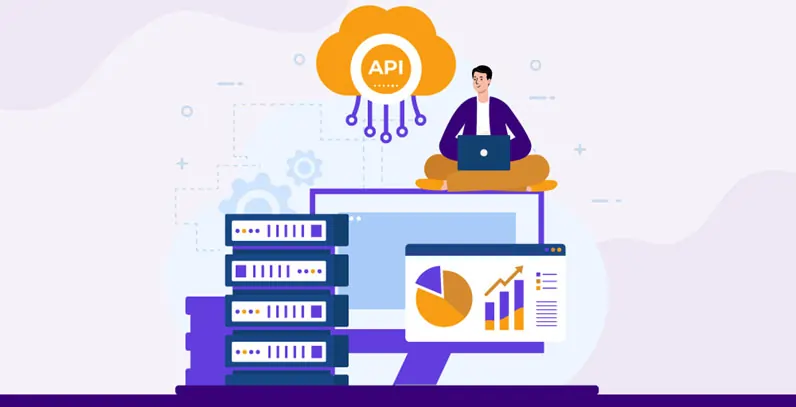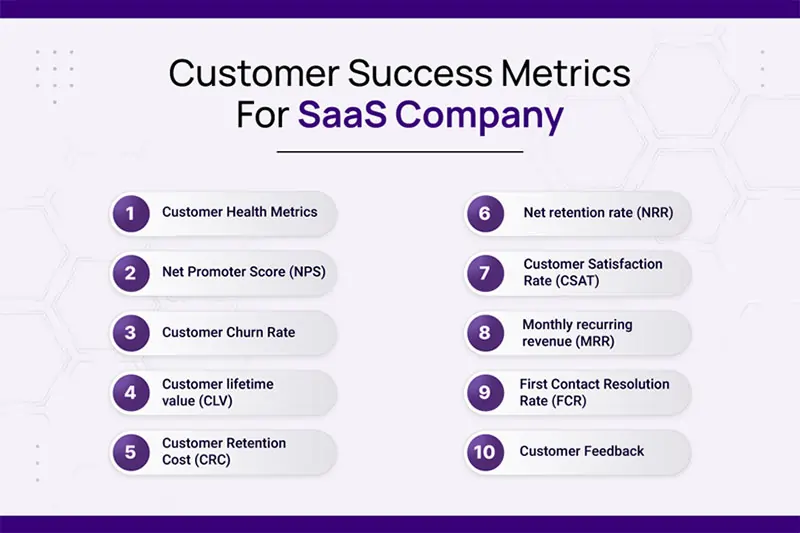Customer Success Metrics Every SaaS Company Should Track
Do you find it challenging to ensure customer satisfaction and retention in your SaaS company? Are you confused about how to contribute to sustained success in your SaaS businesses?

Every SaaS company must measure its customers’ success in this rapidly changing market to determine how well they understand the value of its products and how much they like its offerings. This is where Customer Success Metrics come in.
The customer success metrics provide invaluable insight into your product’s success and satisfaction and can help guide future roadmaps. Without a clear view of such metrics, companies are subject to failure.
In this article, we are going to discuss some of the customer success metrics and how they are important for a SaaS company.
So, let’s get started.
What are Customer Success Metrics?
Customer success metrics are the indicators that measure the effectiveness of the efforts of the company to ensure customer satisfaction throughout its lifecycle. These metrics help identify whether the company has been able to meet its customer’s requirements. It also focuses on the areas for improvement.
Some of the customer success metrics include customer health metrics, net retention rate, first contact resolution rate, customer feedback, etc.
Importance of Customer Success Metrics
Customer success metrics play a crucial role in the growth of a SaaS company. By tracking different customer metrics, the SaaS company can measure and enhance various aspects of customer relationships.
With these metrics, SaaS companies can measure and improve customer experience by identifying areas for improvement in products/ services. Likewise, they can track the impact of customer success initiatives by proactively engaging, supporting, and retaining customers throughout their life cycle. They can also identify future prospects.
Similarly, to further enhance the capability of customer success metrics, many SaaS companies incorporate a second phone number for different marketing campaigns. With this provision in place, they are able to measure the effectiveness of each marketing campaign more accurately – which campaign drives the most engagement and which marketing campaigns didn’t meet target audience needs.
Customer Success Metrics for SaaS Company
Some of the metrics that can be included for customer success for SaaS companies are as follows:

1. Customer Health Metrics
Customer health metrics is a metric that helps a SaaS company to determine the health of its relationship with existing customers. With this metric, a SaaS company can determine healthy customers who are willing to stay loyal to the brand and unhealthy customers who are at higher risk of leaving. They can also identify how actively customers are engaged with their products or services.
This metric comprises the various aspects of customers’ experience, including usage patterns, feedback, sentiments, and retention rates. It is important for the SaaS company as it helps to predict customer behavior at risk and also guides strategic decisions to reduce churn rates.
2. Net Promoter Score (NPS)
Net promoter score (NPS) is a metric that provides insights regarding the clients’ satisfaction and loyalty. It studies customer sentiment regarding recommending the product to someone else. NPS provides both quantitative and qualitative data about customers.
It operates on a simple process: Customers are asked at what rate they will recommend the product or service to others on a ranking of 0 to 10. On the basis of these responses, the customers are categorized into 3 types: promoters (rating 9-10), passives (rating 7-8), and detractors (rating 0-6).
The general formula for NPS is
Net Promoter Score (NPS) = Percentage of promoters – Percentage of Detractors
An increase in NPS indicates that customers are interested in the product, and a low suggests that there are potential churn risks and that improvement is needed.
3. Customer Churn Rate
Customer churn rate is the rate of clients who end their relationships with a brand after a certain time by simply canceling the subscription or stopping using the product. Getting insights into churn rates is significant for SaaS companies since it directly impacts growth and revenue.
To measure the customer churn rate, you can use this formula:
Churn rate = (Number of customers churned) / (Total number of customers at the beginning) * 100
The higher churn rate suggests low customer engagement and satisfaction while the low churn rate shows customers are happy with your product and services.
Usually, a higher churn rate comes from failed expectations and any unresolved issues with the service or product. This churn rate is likely to be reduced if sales representatives maintain a good relationship with customers.
4. Customer Lifetime Value (CLV)
Customer Lifetime Value (CLV) is the sum of revenue that an average client is likely to produce over the entire journey with the company.
With the knowledge of CLV, companies can determine prolonged profitability by measuring the financial value of each customer. The company can also make up-to-date decisions regarding customer acquisition costs, cost models, and resource allocations. Plus, it assists in identifying high-value customer segments and boosting their loyalty, hence reducing churn rates.
CLV can be calculated by:
CLV = Customer value * Customer Lifetime
Where,
Customer value = (Total revenue/ Number of customers)
The higher value of CLV means that the company’s products and services contribute to customer success and vice versa.
5. Customer Retention Cost (CRC)
Customer Retention Cost (CRC) is associated with a company’s financial investment in retaining its customers within a specific period. By analyzing the CRC, the SaaS company will be able to upgrade its customer retention strategies and maximize customer lifetime value. The CRC includes all small to large ranges of expenses, from investment in email campaigns to gifting small presents to customers.
You can calculate CRC by:
CRC = (Total annual cost of customer success & retention initiatives / Number of active customers)
The lower the CRC, the better. Low CRC leads to higher customer lifetime value (CLV) and increased overall profitability. This is because holding on to existing customers requires less cost than acquiring new ones.
Related reading: 10 Techniques For Minimizing Business Premises Costs
6. Net Retention Rate (NRR)
Net Retention Rate (NRR) is the ratio that measures the ability of businesses to expand and retain revenue from existing clients over a specific duration of time. It also estimates the net growth in revenue from the existing customers by considering factors such as renewals, upgrades, expansions, etc.
The formula to calculate NRR is:
NRR = (Revenue at the end of the period – Revenue from churned customers) / Revenue at the start of the period * 100
A positive (higher) NRR indicates that the company is successful in customer retention and growth. It represents effective upselling strategies and overall business growth. The company can experience growth through upsells, cross-sells, and upgrades. Conversely, a low NRR suggests the profit loss from churned customers is greater than the revenue growth.
7. Customer Satisfaction Rate (CSAT)
Customer satisfaction rate calculates how happy customers are with your service or product. This rate can be measured by conducting surveys, post-interaction follow-ups, and feedback forms. The company simply asks customers to rate their satisfaction associated with certain interactions, experiences, or products/services. Usually, the rating ranges from 1 to 5 or sometimes even unsatisfied to very satisfied.
The method for calculating CSAT is as follows:
CSAT = (Number of satisfied customers/ total number of respondents) * 100
A high CSAT rate determines satisfied customers.
By analyzing the CSAT scores, the SaaS company can identify its strengths, work on weaknesses, and customize strategies according to customer preferences. Since this score is entirely focused on customers, businesses need to make sure the experience of the customers is excellent.
8. Monthly Recurring Revenue (MRR)
Monthly Recurring Revenue (MRR) simply determines the sum of the amount the customers spend on your services or products. It predicts the revenue generated from subscription-based users on a monthly basis. MRR provides a clear view of SaaS companies’ revenue streams and growth trajectories. Some benefits of MRR are:
- You can see the level of business growth.
- It helps in forecasting the future.
- Budgeting becomes more easy and accurate.
- Get an overview of teams’ progress.
You can calculate MRR using the formula:
MRR = Average Revenue Per Account (ARPA) * Number of active customers
Higher MRR determines the growth of the customer base, expansion of profit from existing customers, and other factors.
By tracking MRR in a timely manner, the SaaS company can evaluate its financial status, measure the success of retention efforts, and hence make updated decisions.
9. First Contact Resolution Rate (FCR)
First contact Resolution rate (FCR) helps determine the rate of cases resolved within a first interaction. Since time is one of the most important factors for customers, they expect their problems to be solved quickly. If SaaS companies don’t have an effective chat support team, customer satisfaction will immediately fall. By analyzing the FCR, a SaaS business can determine how efficient its company support process is.
It can be calculated by:
FCR = (Number of issues resolved on first contact / total number of customer issues) * 100%
A higher FCR means the customer’s expectations are met promptly, whereas a lower FCR means the company needs to focus on providing efficient chat support service.
Also, it is very crucial for the company to lower its FCR to build long-term customer relationships and stay competitive in the market.
10. Customer Feedback
Customer Feedback is the most critical metric in calculating customer success. It involves collecting and analyzing different opinions and sentiments provided by customers.
The company can collect customer feedback by using various channels, such as performing surveys, filling out feedback forms, customer reviews, one-to-one communication, etc.
By analyzing customer feedback, SaaS companies gain insight into clients’ choices, satisfaction, refinement sector, etc. With the understanding collected from the feedback, companies can identify trends, address issues promptly, and even personalize the product/service to meet customer expectations.
Conclusion
Today, meeting customers’ expectations is crucial for businesses’ revenue growth. Therefore, it is mandatory for any SaaS company to identify and utilize customer success metrics. Customer success metrics help businesses measure the results of the strategies implied to confirm that customers are satisfied throughout their lifecycle with the brand.
Hence, customer success metrics such as customer health metrics, net promoter score, customer lifetime value, customer retention rate, etc., should all be measured for any SaaS company to compete in the market.
Frequently Asked Questions (FAQs)
- Is NPS a customer success metric?
Yes, the Net promoter score (NPS) is considered as success metric since it is used to evaluate customer loyalty and satisfaction. It measures the probability of the customer recommending a service/ product to others, depending upon their own experience.
- How often should I track customer success metrics?
The frequency of tracking customer success metrics completely depends upon the needs and requirements of the businesses. However, it is often recommended to track these metrics regularly, such as monthly, quarterly, and half-yearly, as preferred. Tracking these metrics regularly allows businesses to stay proactive in addressing the customers’ needs.
- What are some tools that can help me track customer success metrics?
Some tools that will assist you in tracking customer success metrics are:
- Qualaroo
- Gainsight
- Pendo

